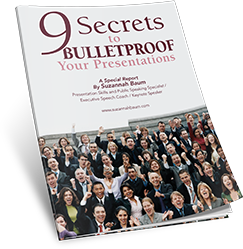How to make your speech delivery outstanding… with thanks to Sheryl Sandberg’s TED Talk
Sheryl Sandberg is the chief operating officer of Facebook and is ranked as one of the 50 Most Powerful Women in Business by Fortune and as one of Time’s 100 Most Influential People in the World. In January 2014, she did a TED interview which followed up to her groundbreaking 2010 TED talk, Why We Have Too Few Women Leaders, in which she described how women unintentionally hold themselves back in their careers.
It was clear from the start that this talk has a solid structure, relevant statistics and stories that back up her content, she opens and closes the speech with impact, addresses the main problem within 45 seconds, she uses the “rule of 3” to both introduce her key points and as calls-to-action, and every point has a story/example attached to it. Awesome. So this gave me an opportunity to dig a little deeper into some ‘intricacies’ in her delivery, and it brought up some really interesting points regarding speech delivery which, had Sheryl used them in a different way, could have greatly enhanced her overall delivery:
- The “So I said,” “so he said” “then I said” dialogue loop
- A little performance goes a long way
- Don’t step on your laughs!
1. The “So I said,” “so he said” “then I said” dialogue loop: A big part of telling stories is to recount the dialogue of the main players, and very often (I’ll even venture to say “most of the time”), it comes out as a “So I said….” “so he said…” “so I said….”. Which is, of course, a very conversational way to do it, and exactly how we’d recount the story if we were sitting across from a friend. But on stage, it falls flat. Here’s a better way.
First, let’s take a few steps back. In Sheryl’s talk, she recounts a story of her pitching a deal, and the dialogue goes like this (at 1:40 of the speech):
“The partner stands up and starts looking really embarrassed, and I realized, he doesn’t know where the women’s room is in his office.
– And I said “Did you just move into this office?”
– And he said “No, we’ve been here about a year”
– And I said “Are you telling me that I’m the only woman who’s ever pitched a deal in this office in a year?”
– And he looked at me and he said: “Yeah, or maybe you’re the only one who had to go to the bathroom.”
The “I said” “he said” breaks up the momentum and impact of the dialogue. It would be so much more effective – and more real – if she could tell the story of that conversation without having to inject the “I said” “he said” every few seconds. So how do you do it?
Years ago, I had the privilege of hearing corporate storyteller Doug Stevenson speak at a conference, and this is what he suggested:
Stand in one spot, at a slight angle to the audience. Deliver Person #1’s dialogue (without the “I said…”). When you’re ready to respond as Person #2, shift your feet and angle yourself to the audience from the opposite side, almost so that it’s like you’re facing Person #1 from an angle. In other words, as Person #1, your body is diagonal to the right side of the stage, and as Person #2, your body is diagonal to the left side of the stage. This way, you can have the conversation as both individuals, with the subtle shift of your feet clearly indicating who is speaking and who is responding. It’s a subtle move, but very effective in re-telling a conversation, almost as if allowing your audience to “eavesdrop” on a conversation.
The other way is, of course, to add a bit more “theatre” into your speech by taking on components of the other person’s persona. Doug gives a great example of this in this video, starting at around 4:05, where he takes on the tone of voice and mannerisms of his stepson in the dialogue. A little harder to pull off for some people, and you’ve got to have the confidence for it, but it works!
It’s all about subtle movements that allow your audience to not only HEAR the stories, but to visualize the actual situation. They create more vivid pictures in your audience’s minds. Share on X2. A little performance goes a long way (4:17)
At 4:17 of her speech, Sheryl tells the story of two high-level female executives who declined the invitation to sit at the conference table with the other executives. This story helps her highlight the main problem facing women, and it could have been made more powerful by a few subtle movements that ‘act out’ the refusal.
Sheryl tells the story like this: “I kinda asked them to sit at the table, I said “come on, sit at the table,” and they sat at the side of the room.”
Think of how much more effective could it have been if she had SHOWN us how they refused. Try to imagine this scenario:
“So I said, come on, sit at the table”, using a motion to point to an object beside her – the ‘conference table’ – and inviting them to sit there. (For the audience, this creates the visual of a conference table).
Pause.
Sheryl then takes a step back, which effectively takes her a step away from the ‘conference table’, and adopts the persona of one of the women. For the audience, this creates the visual of the chairs beside the conference table.
Make subtle motion as if she’s sitting in a chair.
Wave away the invitation (in the “oh no, that’s OK, I’m fine over here”).
Step forward (which puts her back as the speaker).
“And they sat at the side of the room.” (pointing at the ‘chairs’ at the side of the room).
Again, it isn’t theatre, but it’s all about subtle movements that allow your audience to not only HEAR the stories, but to visualize the actual situation. They create more vivid pictures in your audience’s minds. They don’t take much time, effort, or theatrical ability. But they leave a much greater impact than just words.
3. Don’t step on your laugh!

The lesson: If your audience laughs at something you said, let them laugh. Enjoy the moment. Don’t rush your way back into the speech.
The lesson: If your audience laughs at something you said, let them laugh. Enjoy the moment. Don’t rush your way back into the speech. Share on XAside from being a fascinating talk, Sheryl is a credible source to be delivering it, and her personal and professional experience speaks for itself. It’s no wonder that this speech caused such a shift in the discussion of women in the workplace, and it’s well worth the watch.
And here’s the follow-up interview from Jan. 2014, if you want to take a look:
-
[…] my Create A Signature Speech That Sells online speech-creation program), that inspired me to write a review of Sheryl Sandberg’s TED speech a few years […]




I ALWAYS learn something new from you, Suzannah. Really.
I will remember those points, especially the “I said” “he said” loop!
Thank you!
Thank YOU, Sarena. The “I said” “he said” dialogue loop feels a bit awkward to overcome at the beginning, but with enough practice (and some mustered-up confidence), it makes a HUGE difference in engaging the audience and bringing them into the story.
I really appreciate your feedback, as always.
Excellent post, Suzannah. I love that you took a strong speech, pointed out many things that were right with it, yet also pointed out ways it could be better.
Sometimes I’ve found it empowering in the past to look at talks given by “presentation gurus” and analyse what rocked (so I could aim to emulate it) and what didn’t (so I could try to improve on it).
One technical tip I can offer is that if you want to, here’s how to publish a direct link to any point in a talk on YouTube. So that’s handy where you refer to a specific point on the timeline (like 1:40 or 5:17), to take people straight to the segment you mean.
Again, thanks for the analysis and the tips. I’ve found them very helpful.
Craig, a million apologies for not responding to your valuable comments about this talk back when you posted it. I actually thought that I had responded, but in fact, I see that I hadn’t. Your comments are very appreciated, and I truly apologize about the silence.
So let me say first of all that like you, I love watching the pros to see how they construct and deliver speeches, and then I love watching them to see if there’s anything that could be improved upon by us mere mortals. Thank goodness TED has so many amazing speeches to learn from.
And THANK YOU for your tips on how to publish a direct link. That’ll be very useful for future posts, as well as in my trainings. Very appreciated!
By the way, recently I’ve seen lots of slides with imperfect circles or squares on them, like the “No” symbol near the end of your post.
So I just posted a video that shows a couple of tips for drawing perfect shapes, plus a neat way to centre the shape even while you’re still drawing it:
http://wp.me/p1PHR3-12v
As always, any comments or critiques are very welcome.
This is so useful, Craig! Thank you – again – for sharing your expertise in this forum.